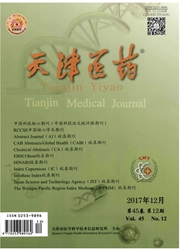

 中文摘要:
中文摘要:
目的:探讨头颈部鳞状细胞癌(HNSCC)中细胞周期素依赖蛋白激酶5(CDK5)及上皮间充质转化(EMT)相关蛋白N-钙黏蛋白(N-cadherin)、波形蛋白(Vimentin)及E-钙黏蛋白(E-cadherin)表达,以及CDK5的表达与患者预后的关系。方法免疫组化方法检测55例HNSCC患者癌组织中CDK5及EMT相关蛋白的表达情况;分析不同临床病理特征患者CDK5及EMT相关蛋白表达的差异,CDK5与EMT相关蛋白表达的相关性,以及CDK5表达与患者生存之间的关系。结果 CDK5高表达率在有淋巴结转移患者中高于无淋巴结转移患者(91.67%vs 30.23%, P〈0.05),在T3~T4期患者中高于T1~T2期患者(85%vs 20%, P〈0.05);有淋巴结转移患者N-cadherin、Vimentin高表达率高于无淋巴结转移的患者(75.00%vs 6.98%;91.67%vs 27.91%,均P〈0.05),E-cadherin高表达率低于无淋巴结转移的患者(8.33%vs 86.05%, P〈0.05);CDK5与N-cadherin、Vimentin表达呈正相关,与E-cadherin表达呈负相关(rs分别为0.512、0.443、-0.363,均P〈0.01);CDK5高表达患者3年生存率低于低表达患者(37.5%vs 87.0%,Log-rankχ2=12.678,P〈0.01)。结论 CDK5及EMT相关蛋白在转移性HNSCC中异常表达;CDK5的表达状态对预测HNSCC患者的预后有一定价值。
 英文摘要:
英文摘要:
Objective To explore the expressions of Cyclin-dependent kinase 5 (CDK5) and Epithelial-Mesenchymal Transition (EMT) related proteins including N-cadherin, Vimentin and E-cadherin in head and neck squamous cell carcino ma (HNSCC), and to determine the relationship between the expression of CDK5 and prognosis. Methods The expression levels of CDK5 and EMT related proteins were evaluated by immunohistochemistry in 55 patients who were diagnosed as HNSCC. They were also analyzed in different clinical pathological factors. The correlation of CDK5 and EMT related proteins as well as the relationship between the expression of CDK5 and prognosis were also analyzed. Results The expression level of CDK5 was significantly higher in patients with lymph node metastasis than that in patients with non-lymph node metastasis (91.67%vs 30.23%, P〈0.05). It’s also higher in T3-T4 stages than that in T1-T2 stages (85%vs 20%, P〈0.05). The expression levels of N-cadherin and Vimentin were significantly higher in patients with lymph node metastasis than those in patients with non-lymph node metastasis (75.00%vs 6.98%;91.67%vs 27.91%, all P〈0.05). However, the expression level of E-cadherin was significantly lower in patients with lymph node metastasis (8.33%vs 86.05%, P〈0.05) compared to that in patients without. CDK5 was positively correlated with N-cadherin and Vimentin, but negatively correlated with E-cadherin (rs=0.512, 0.443,-0.363, all P〈0.01). The 3-year survival rates were significantly lower in patients with high expression of CDK5 (37.5%) than that in patients with low expression of CDK5 (87%, Log-rankχ2=12.678, P〈0.01). Conclusion CDK5 and EMT related proteins were activated abnormally in HNSCC with lymph node metastasis. CDK5 may be a new biological marker for prognosis of HNSCC.
 同期刊论文项目
同期刊论文项目
 同项目期刊论文
同项目期刊论文
 Long Non Coding RNA MALAT1 Promotes Tumor Growth and Metastasis by inducing Epithelial-Mesenchymal T
Long Non Coding RNA MALAT1 Promotes Tumor Growth and Metastasis by inducing Epithelial-Mesenchymal T Targeting HOTAIR Induces Mitochondria Related Apoptosis and Inhibits Tumor Growth in Head and Neck S
Targeting HOTAIR Induces Mitochondria Related Apoptosis and Inhibits Tumor Growth in Head and Neck S C60 carboxyfullerene-based functionalised nanohybrids as signal-amplifying tags for the ultrasensiti
C60 carboxyfullerene-based functionalised nanohybrids as signal-amplifying tags for the ultrasensiti C carboxyfullerene-based functionalised nanohybrids as signal-amplifying tags for the ultrasensitive
C carboxyfullerene-based functionalised nanohybrids as signal-amplifying tags for the ultrasensitive Targeting EZH2 regulates tumor growth and apoptosis through modulating mitochondria dependent cell-d
Targeting EZH2 regulates tumor growth and apoptosis through modulating mitochondria dependent cell-d 期刊信息
期刊信息
